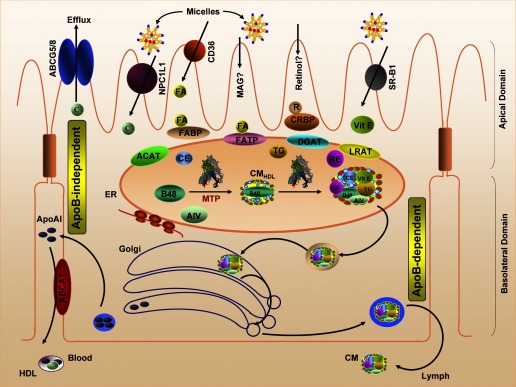Fig. 1.

Intestinal lipid absorption. Products of lipid hydrolysis are solubilized in micelles and presented to the apical membranes of enterocytes. This membrane harbors several transport proteins that participate in the uptake of various types of lipids. Niemann-Pick C1 like 1 (NPC1L1) is a protein involved in cholesterol uptake. CD36 and fatty acid (FA) transport protein (FATP) have been shown to participate in FA transport, whereas scavenger receptor class B type I (SR-BI) is involved in vitamin E (Vit E) uptake. In the cytosol, FA-binding protein (FABP) and cellular retinol-binding protein (CRBP) transport FAs and retinol (R), respectively. Acyl-CoA:cholesterol acyltransferase (ACAT), diacylglycerol acyltransferase (DGAT), and lecithin:retinol acyltransferase (LRAT) are found in the endoplasmic reticulum (ER) membrane, where they facilitate the esterification of cholesterol, monoacylglycerols (MAG), and retinol, respectively. These esterified products are incorporated into apolipoprotein (apo)B48-containing chylomicrons (CM) in a microsomal triglyceride (TG) transport protein (MTP)-dependent manner. The newly synthesized prechylomicrons are transported in specialized vesicles to the Golgi apparatus for further processing and for secretion. In addition, enterocytes express ATP-binding cassette (ABC) transporter A1 on the basolateral membrane to facilitate the efflux of cholesterol. C, free cholesterol; RE, retinyl ester; CE, cholesteryl ester; AIV, apolipoprotein A-IV.
